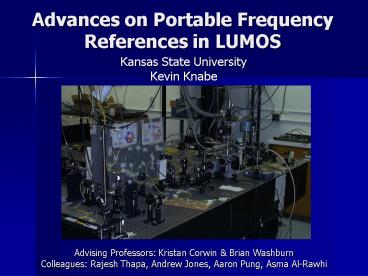Advances on Portable Frequency References in LUMOS - PowerPoint PPT Presentation
1 / 28
Title:
Advances on Portable Frequency References in LUMOS
Description:
Advances on Portable Frequency References in LUMOS – PowerPoint PPT presentation
Number of Views:66
Avg rating:3.0/5.0
Title: Advances on Portable Frequency References in LUMOS
1
Advances on Portable Frequency References in LUMOS
- Kansas State University
- Kevin Knabe
Advising Professors Kristan Corwin Brian
Washburn Colleagues Rajesh Thapa, Andrew Jones,
Aaron Pung, Asma Al-Rawhi
2
Outline
- Goals
- Overview of Frequency Standards
- Saturated Absorption Spectroscopy
- Fiber Cells
- Reflected Pump Setup (single beam!)
- Locking
- Update on the CrF Laser
3
Goals
- Studying ?1 ?3 vibrational band of acetylene
(optimize signal for locking) - Create an acetylene cell using Photonic BandGap
(PBG) Fiber and Single Mode Fiber (SMF) - Lock a laser to absorption signal
4
Acetylene as Frequency Reference
- High accuracy ( 2 kHz)
- Moderate accuracy ( 100 MHz)
8.5 mW
100 mW
Figure from K. Nakagawa et al., JOSAB 13, 2708
(1996)
Complex, fragile
Portable, robust -gt Large linewidths
Our Goal Combine portability with improved
accuracy
- Saturation spectroscopy pump-probe technique
- Long interaction lengths
5
Saturated Absorption
Pump burns hole in velocity distribution, probe
samples different velocity class, except when on
resonance.
Doppler-broadened line width
l
Sub-Doppler line width
Pump and probe at same frequency
6
Theory of Saturated Absorption
Gas Cell
Beers Law
- Pump and probe burn independent holes while
scanning velocity classes - The only time they see each other is when they
are resonant - Ipump gtgt Iprobe (Iprobe lt (0.05) Ipump)
7
Pump-Probe Setup
PBGF acts like a waveplate!!
8
Photonic Bandgap Fibers
- 10 mm fiber- 7 missing cells
- 7.5 µm mode field diameter
- 20 mm fiber- 19 missing cells
- 13.5 µm mode field diameter
Allows for long interaction lengths!
Images by Crystal Fibre A/S
9
Typical Data
Uneven background in 10 µm attributed to coupling
into surface modes due to small mode field
diameter
Good signal quality, small widths
10
Pressure Results
- 20 µm fiber shows lower fundamental width at
zero pressure larger transit time, so less
broadening!
Mode field radius of fiber
R. Thapa, K. Knabe, M. Faheem, A. Naweed, O. L.
Weaver, and K. L. Corwin, "Saturated absorption
spectroscopy of acetylene gas inside large-core
photonic bandgap fiber," Opt. Lett. 31, 2489
(2006).
11
Power Results
- Power broadening widens transition, but
discrimination keeps going up - Because of availability of additional laser
sources, staying under 50 mW may be a requirement
(EDFAs are expensive)
12
Goals
- Studying ?1 ?3 vibrational band of acetylene
(optimize signal for locking) - Create an acetylene cell using Photonic BandGap
(PBG) Fiber and Single Mode Fiber (SMF) - Lock a laser to absorption signal
13
The Splice is Right
Half Cell
LUMOS Spliced Fiber (2005) - 20 µm core Splice
Loss PBG -gtSMF 2.0 dB (30) SMF -gtPBG 0.5 dB
(10)
20 µm core PBG supports more than 1 mode!
Arc fusion splicing of hollow-core photonic
bandgap fibers for gas-filled fiber cells R.
Thapa, K. L. Corwin, and B. R. Washburn, Accepted
to Optics Express 2006
14
Making Fiber Cells
SMF
PBG
SMF
We will have a robust portable fiber cell!
15
Goals
- Studying ?1 ?3 vibrational band of acetylene
(optimize signal for locking) - Create an acetylene cell using Photonic BandGap
(PBG) Fiber and Single Mode Fiber (SMF) - New Goal Check quality of half cells
- Lock a laser to absorption signal
16
Saturated Absorption Spectroscopy With Only 1
Beam in PBG Fiber
Patent pending
17
Pump-Probe Setup for Spliced Half-Cells
Pump
Probe
18
Pump-Probe Setup for Spliced Half-Cells No AOM
Pump
Probe
19
Reflected Pump Setup
Pump
Probe
20
R-Pump Results Signal Quality
- Keeping saturated absorption feature centered
with Doppler broadened profile has locking
benefits - Wings exhibit very small interference pattern
which has a free spectral range associated with
the length of the PBG fiber - Reflections occurring at front end of splice,
causing interference
21
R-Pump Results Comparison Of Widths
R-Pump P11 Line Pressure 0.5
torr Pump-Probe P11 Line Pressure 1 torr
R-Pump P11 Line Pump Power 30 mW Pump-Probe
P11 Line Pump Power 29 mW
22
Goals
- Studying ?1 ?3 vibrational band of acetylene
(optimize signal for locking) - Create an acetylene cell using Photonic BandGap
(PBG) Fiber and Single Mode Fiber (SMF) - Check quality of half cells
- Lock a laser to absorption signal, then compare
with locked CrF frequency comb
23
Locking
1550nm ECLD
Locking Electronics
Pump
Probe
AOM
PBG Cell
C2H2 molecules
- Lock laser to sat. abs feature.
- Measure with comb referenced to GPS.
- Lock comb to fiber-based reference, output stable
microwaves.
24
Chromium Forsterite Update
25
CrF Spectra
Supercontinuum Using HNLF to generate
supercontinuum from 1000nm to 2250 nm
- Laser out of oscillator
- 70 nm BW _at_ 1280 nm center ?
26
f-2f Interferometer
- Using Periodically Poled Lithium Niobate to get
2nd harmonics - Got 47 dB beat note signal
- Have also locked repetition rate
- Currently Rajesh is playing with pump power
modulation and other servo controls to lock f0
27
Conclusion
- Characterization has been done on acetylene
filled PBG fibers - Advances have been made on making gas filled
cells - Discovery of the Reflected-Pump technique
- CrF is close to being locked!
- Next Lock Laser to saturated absorption signal
28
Thanks
- Funding Agencies
- AFOSR
- NSF CAREER
- Kansas NSF EPSCoR program
- Kansas Technology Enterprise Corporation
- Kansas State University
- Mike Wells and the JRM Staff































